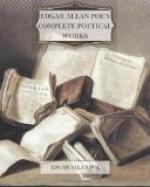Of course I pretend to no originality in either the rhythm or metre of the “Raven.” The former is trochaic—the latter is octametre acatalectic, alternating with heptametre catalectic repeated in the refrain of the fifth verse, and terminating with tetrametre catalectic. Less pedantically, the feet employed throughout (trochees) consists of a long syllable followed by a short; the first line of the stanza consists of eight of these feet, the second of seven and a half (in effect two-thirds), the third of eight, the fourth of seven and a half, the fifth the same, the sixth three and a half. Now, each of these lines taken individually has been employed before, and what originality the “Raven” has, is in their combinations into stanzas; nothing even remotely approaching this combination has ever been attempted. The effect of this originality of combination is aided by other unusual and some altogether novel effects, arising from an extension of the application of the principles of rhyme and alliteration.
The next point to be considered was the mode of bringing together the lover and the Raven—and the first branch of this consideration was the locale. For this the most natural suggestion might seem to be a forest, or the fields—but it has always appeared to me that a close circumscription of space is absolutely necessary to the effect of insulated incident—it has the force of a frame to a picture. It has an indisputable moral power in keeping concentrated the attention, and, of course, must not be confounded with mere unity of place.
I determined, then, to place the lover in his chamber—in a chamber rendered sacred to him by memories of her who had frequented it. The room is represented as richly furnished—this in mere pursuance of the ideas I have already explained on the subject of Beauty, as the sole true poetical thesis.
The locale being thus determined, I had now to introduce the bird—and the thought of introducing him through the window was inevitable. The idea of making the lover suppose, in the first instance, that the flapping of the wings of the bird against the shutter, is a “tapping” at the door, originated in a wish to increase, by prolonging, the reader’s curiosity, and in a desire to admit the incidental effect arising from the lover’s throwing open the door, finding all dark, and thence adopting the half-fancy that it was the spirit of his mistress that knocked.
I made the night tempestuous, first to account for the Raven’s seeking admission, and secondly, for the effect of contrast with the (physical) serenity within the chamber.
I made the bird alight on the bust of Pallas, also for the effect of contrast between the marble and the plumage—it being understood that the bust was absolutely suggested by the bird—the bust of Pallas being chosen, first, as most in keeping with the scholarship of the lover, and, secondly, for the sonorousness of the word, Pallas, itself.




